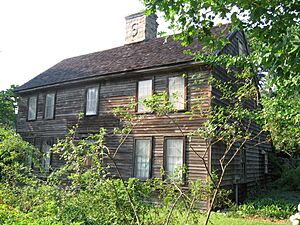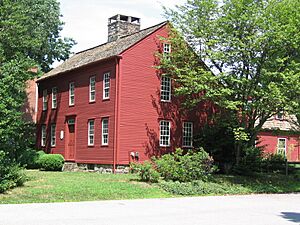History of Darien, Connecticut facts for kids
The town of Darien, Connecticut, has a rich history. Its story is shaped by its location right on the Long Island Sound. It's also on the main travel route between Boston and New York City. In the past, people traveled by sailing ships and dirt roads. Later, trains and highways made travel faster.
Contents
Early Days in Darien: Colonial Times
Long ago, the Siwanoy people lived in the area that is now Darien. They were a group (or subtribe) of the Wappinger tribe. They spoke an Algonquian language. The Siwanoy controlled a large area, including parts of New York and Connecticut.
The land that became Darien was part of Stamford for many years. This was true from when Stamford bought the land from the Native Americans. Darien officially became its own town in 1820.
Settlers started building homes in the late 1600s. They got permission from Stamford to build roads "in the woods." Early settlements grew in three main spots:
- Around "Noroton Cove" (now Holly Pond) in the southwest.
- At Gorham's Landing on the Goodwives River in the south-central area.
- At the top of the Five Mile River, near where Darien borders Norwalk today.
The Noroton Cove settlement had a sawmill. It was built near the Noroton River, which is now the border with Stamford. A small shipyard also started on the shore of Holly Pond. The oldest house in Darien was built around 1696. It's a saltbox style home owned by Nathaniel Pond, a local blacksmith.
In 1690, the Five Mile River settlement began. John Reed and his son built a sawmill there.
By 1703, a school district was set up in Noroton. Five years later, Scofield's Mill (later Gorham's Mill) was built on the Goodwives River.
Moses Mather and the Middlesex Parish Church

In the late 1730s, harsh winters made it hard for people from Darien to get to church in Stamford. This led to the idea of creating a new church closer to home. It took seven years to agree on things like the preacher's salary.
Finally, they hired Rev. Moses Mather in 1744. He was a Yale graduate from Lyme, Connecticut. He stayed as the minister for 64 years until he passed away in 1806.
The church, later known as the First Congregational Church, had its first meeting on June 15, 1739. A meetinghouse was also built that same year.
Rev. Mather was married three times and had 10 children. He was known for being smart and public-spirited. He was very interested in new ideas about politics. During the American Revolution, he was a strong supporter of the Patriot cause. He often spoke about fighting for freedom.
People described Mather as a learned and kind person. He had a great sense of humor and was very patriotic. He even received a special degree from Princeton in 1791.
Darien During the American Revolution
Near the start of the American Revolution, General George Washington and his army marched through Middlesex Parish. They were on their way from Boston to New York City. The main road they used is now called "Old Kings Highway."
During the war, Middlesex Parish was controlled by Patriots. However, it was often attacked by local Tories. Tories were people who supported the British. Many had fled to British-controlled Long Island. They would row across the Sound in whaleboats to steal food and clothes. These raids could be very dangerous.
At that time, Middlesex Parish had many Anglican families and many Congregational church members. Anglicans often supported the British (Tories). Congregationalists usually supported the American cause (Patriots).
On July 22, 1781, Tory raiders attacked the meetinghouse. They captured Dr. Mather and 26 other men. They were taken across the Sound and held in British prisons in New York City. Those who survived were later set free and returned home.
Another raid happened on August 2, 1781. Patriots hid behind a stone wall to ambush the Tories. But the Tories found out and ambushed the Patriots instead. A gunfight broke out, and several men died on both sides. The Tories managed to escape back across the Sound.
In March 1781, Tories robbed the home of Rev. Mather's son, Joseph. Joseph had built his home further from the shore, thinking it would be safer. Friends and family had stored valuables there. The Tories forced the Mathers to show them where the hidden items were. Legend says they even made Mrs. Mather cook dinner for them!
Darien in the Early 1800s
The town of Darien got its name because residents couldn't agree on a new name. Many families wanted to name it after themselves. A sailor who had visited Darién, Panama, suggested the name Darien. Everyone finally agreed on it.
Before the railroad arrived in 1848, Darien was a small farming town. It had about 1,000 people, including farmers, shoemakers, and fishermen. They also traded goods along the coast. Small sailing ships would come to Gorham's Landing to trade.
Some businesses stayed in the area into the 1900s. Rings End Lumber, a successful company today, started at Gorham's Landing. The town's population slowly grew as people from Ireland and Italy moved in.
In the 1830s, a "Union Chapel" was built near the Boston Post Road. It was for religious groups other than the original Congregationalists. St. Luke's Episcopal Church and the Darien Methodist Church started from meetings there. The Noroton Presbyterian Church was formed in 1863. Later, Irish Roman Catholics founded St. John Church nearby in 1888.
The Darien train station opened around 1848. Later, stations were added in Noroton Heights and Glenbrook.
Darien in the Late 1800s
In 1864, during the Civil War, the first home for disabled veterans and soldier's orphans was built in the United States. It was in Noroton Heights. Benjamin Fitch of Darien paid for most of the project. It was named "Fitch's Home for Soldiers."
The home cared for veterans of the Civil War, the Spanish–American War, and World War I. After World War II, its services moved to a larger facility in Rocky Hill, Connecticut.
Until the 1870s, the area around Noroton Avenue and the Boston Post Road was Darien's main business center. The area now called Noroton Heights was simply "Noroton." The current center of town, where the railroad tracks cross the Boston Post Road, was called "Darien Depot." But when the town hall moved there, that area became "Darien." The old commercial center became "Noroton," and the area north of I-95 became "Noroton Heights" after a post office opened there.
After the Civil War, the train made Darien a popular place for wealthy New Yorkers. They built summer homes in Tokeneke, Long Neck Point, and Noroton. Soon, many people started commuting daily to New York City. This changed Darien into a residential suburb.
In 1896, a large home called Glenbreekin was built on a sheep farm. It was located on the Goodwives River. Over time, most of the land was sold off. The house itself was expanded in 1921 and again in 1994.
The famous writer Theodore Dreiser is said to have written his book An American Tragedy in a large estate in Tokeneke.
Darien in the 1900s
In 1902, Anson Phelps Stokes, a New York businessman, bought the southern tip of Long Neck. He built a home called "Brick House." Andrew Carnegie, a very rich businessman, stayed there several summers.
In 1916, Carnegie's wife wrote about how they loved being at Brick House. She said their yacht was always nearby.
Later, the property became the Convent of the Sacred Heart. It was an elite girls' school. Sisters of President John F. Kennedy, like Eunice Kennedy Shriver and Kathleen Kennedy, went to school there.
On September 5, 1929, Darien's movie theater opened. It could seat 700 people and attracted moviegoers from nearby towns. Community events were sometimes held there too.
St. Thomas More Roman Catholic Church was started on September 16, 1966. It was built on the property of St. John's Parochial School. The new church building was dedicated on October 27, 1973.
In 1970, Post 53 began operating. It's a scout Explorer post that also serves as the town's ambulance service.
Developing Darien's Neighborhoods
Around the early 1900s, different parts of Darien were developed for homes.
Cars on the Stamford-Norwalk trolley line served Darien, Noroton, and Noroton Heights. The trolley ran along the Post Road (U.S. 1). Trolley service continued until 1935.
The Growth of Tokeneke
The Tokeneke Corp. started selling land and summer homes in 1901. In 1904, they built the Tokeneke Inn for visitors. In 1909, they started the Tokeneke Beach Club. This allowed landowners without waterfront property to enjoy the shoreline.
Eventually, a property owner's association took over the roads in Tokeneke. The town didn't want to take them over because they were narrow and winding.
In 1914, Tokeneke Road was built. When it was paved in 1919, Tokeneke residents started using the Darien train station.
Noroton Shores Development
In January 1926, Noroton Shores Inc. began developing the peninsula around Nearwater Lane. They dug out a lot of dirt from the Good Wives River. This work went on for about 11 months. A large stone barrier was also built. Later, the Noroton Yacht Club bought some of the waterfront land. In 1928, a second pier was built.
The company also built paved roads and water lines for the new homes.
Other Coastal Developments
"Ceder Gate," a 40-acre area near Tokeneke, began development around 1912. In 1927, "Salem Straits" started developing 56 acres of wooded land. Property owners in Salem Straits had rules about how their homes should look.
Between Salem Straits and Cedar Gate, the Delafield Estates Association was formed. This area was originally part of the Delafield family's large estate.
Darien in the 2000s
On September 11, 2001, six Darien residents died in the terrorist attacks. They were all at the World Trade Center in New York City.
On July 11, 2006, lightning struck the Convent of St. Birgitta. It caused a lot of damage to the building.
Darien's Population Over Time
| Historical population of Darien[1] |
|
| 1820 | 1,126 |
| 1830 | 1,212 |
| 1840 | 1,080 |
| 1850 | 1,454 |
| 1860 | 1,705 |
| 1870 | 1,808 |
| 1880 | 1,949 |
| 1890 | 2,276 |
| 1900 | 3,116 |
| 1910 | 3,946 |
| 1920 | 4,184 |
| 1930 | 6,951 |
| 1940 | 9,222 |
| 1950 | 11,767 |
| 1960 | 18,437 |
| 1970 | 20,336 |
| 1980 | 18,892 |
| 1990 | 18,196 |
| 2000 | 19,607 |
| 2010 | 20,752 |
| 2020 | 21,742 |
Historic Places in Darien
Several places in Darien are listed on the National Register of Historic Places. This means they are important historical sites.
- Boston Post Road Historic District – This area includes several roads and buildings. (added 1982)
- DCA Meadowlands – This is the headquarters for the Darien Community Association. (added November 6, 1987)
- Pond-Weed House – Located on Post Road, this Saltbox style home is the oldest house in town. (added November 11, 1978)
- Stephen Tyng Mather House – Located on Stephen Mather Rd. (added November 15, 1966)








